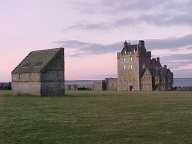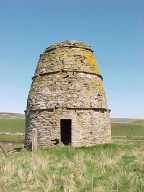 | Caithness.Org | Community | Business | Entertainment | Caithness... | Tourist Info | Site Map |
• Advertising • Chat Room • Contact Us • Kids Links • Links • Messageboard • News - Local & Scottish • News - UK & News Links • About / Contact Us • Submissions |
• Bookshop • Business Index & News • Jobs • Property For Sale • Property For Rent • Shop • Sutherland Business Index |
• Fishing • Fun Stuff • George, The Saga • Horses • Local Galas • Music • Pub Guide • Sport Index • What's On In Caithness |
• General Information • B & Bs • Backpackers • Caravan & Camping • Ferries • Getting Here • Holiday Letting • Hotels • Orkney • Pentland Firth • Sutherland • Taxis |
| N E W S F E E D S >>> |
|
Notes On Three Caithness Doocots Dale House, Westerdale Halkirk Parish Internally, the cote, like that at Freswick, resembles more the straw bee skep than the bottle kiln the, internal form producing a funnel towards the apex favoured in Moray and Banff/Buchan. The apex entrance is large and is the only ingress for the birds. The cote is in reasonable repair. I am sure that this cote pre-dates Dale House (early eighteenth century) and suggest a seventeenth century date. This cote, with the chapel on the same site, may suggest an earlier house of pretension. Measurements: |
|
Freswick - Canisbay Parish There are two entrance doors, which is most unusual, one on the east which, from its proportions (1 -5m x lm), would seem original.
(Beehive doocots some times have their entrances on the east, though not their pigeon-ports if these exist). The entrance on the south wall is tall
and narrow (1.7m x 0.60m). | |
|
Internally the nesting boxes start 1.8m above floor level - while 0.6m to lm above floor level is common and helps to keep vermin away from the boxes - 1.8m is most unusual. The walls up to the boxes have been plastered and are smoke blackened - have the lower boxes been blocked at some later date and the cote used as a kiln? If so, the south entrance may have something to do with this re-use. Measurements:
| |
|
Ackergill - Wick Parish | |
|
The eastern cote is double chambered with approximately nine hundred nice, regular boxes of slate-like stone in each chamber, starting at lm from groundfloor. Each chamber is served by its earn door on the north side and by a swept dormer on the south. On the south wall are also two blocked windows one to each chamber. There is a long crack running down the west side, and the roof is beginning to go. The west cote offers problems - it now has single chamber, but a blocked door on the eastern side of the north wall suggests it had two chambers. The two windows on the south side are not blocked. Internally there are no nesting boxes and no signs that they are there but blocked. The thickness of the walls are the same as those of the eastern cote. There are the remains of beams creating a low ceilinged ground floor room and a first floor room that was also ceiled at the height of the south wallhead. Also there is a fire place in the north wall of this room. No visible means of access to upper floor but the framing of the beams at the south west corner suggest a trap door or aperture for a ladder. Without a ladder I was not able to get up to the fire place and examine it and the chimney flu (no external sign of a chimney).
Possibly the flu measurements might suggest that it has been created in the thickness of the wall left after the removal of the boxes. The story then
might be that at some time, probably in the nineteenth century, one cote was deemed sufficient for the needs of the, household (some eighteen hundred
pairs of birds is a lot let alone three and a half thousand or so!) and the, western cote was altered for use as a cattle shelter on the ground floor
and a bothy or chamber for farm servants in the heated room. This raises the query "did the incumbents of Ackergill want cattle and farm servants
close to the front aspect of their considerable mansion?' Perhaps a 'garden room" is the answer. | |
| Measurements: East cote - 5m X 8m West cote - 5m x 8.5m (Long walls SW and NE) Wall thickness 0.8m Boxes: 0.3in deep 0.25m wide |  |
|
Caithness.org Notes Merriam Webster dictionary definition Other Information | |











